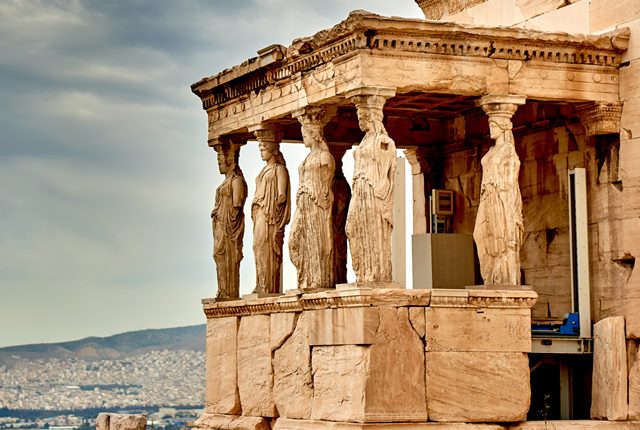Rome, the capital of the Roman Empire, is a genuine gold mine of antiquated treasures. Undoubtedly, one of its most identifiable sites is the magnificent Colosseum. Built between AD 70 and 80, the remarkably well-preserved Amphitheatre was intended to hold public performances, gladiator bouts, and sports. Imagine the strong emperors and hundreds of onlookers applauding as you go around the historic arena. The Pantheon, a temple that was first built between 25 and 27 BC and subsequently rebuilt over seven years starting in AD 118 by the emperor Hadrian, is another of the city's most famous landmarks.
Athens, Greece
Athens, the birthplace of modern democracy, is the ideal place to begin any investigation into Greece's extraordinary past. Start by visiting the Acropolis, which is a rocky hill above the city and is home to some of the most famous structures from antiquity, including the Parthenon. One of the earliest structures erected here was the Doric temple, which dates to about 447 and 438 BC. It was devoted to the city's patron goddess, Athena Parthenos.
Tikal, Guatemala

For a glimpse inside the mysterious Mayan Empire of Guatemala, visit Tikal National Park in the country's north. An estimated 100,000 people made up the Mayan civilization that lived in the deep forest and constructed the amazing and complicated temples, palaces, plazas, and well-known stone pyramids. The location was abandoned after the population, which peaked in the eighteenth century, decreased about a century later.
Yaxha, Guatemala
Approximately 20 miles (32 km) southeast of Tikal, the ancient city of Yaxha is another must-see site for Mayan ruins in Guatemala. Situated deep in the bush, this stunning ruin is the third biggest in the nation. Numerous buildings may be seen at the site, including as acropolises, ball courts, and astronomical observatories, for which the Mayans were particularly well-known. Although people have lived on the site since at least 700 BC, it reached its peak in the eighth century, when up to 40,000 people may have called it home.
Parsa, Iran
One of the most amazing ancient Persian artifacts is Persepolis, the former capital and site of the Achaemenid dynasty's monarchs, which is recognized as a UNESCO World Heritage Site. Built in the years of King Darius the Great (522–486), the city was formerly known as Parsa. Persian City is what the Greek term Persepolis means. Prior to being attacked and plundered by Alexander the Great in 330 BC, the city was prosperous and stunning.
Petra, Jordan
Jordan's greatest treasure and a marvel of the world is the desert kingdom of Petra. More than 2,000 years ago, the Nabataeans, a nomadic tribe that finally settled, carved it out of a steep rock face. This capital city served as the hub of their prosperous trade empire, connecting east and west. The impressive site features several attractions, including the Siq, Treasury, Colonnaded Street, High Place of Sacrifice, Royal Tombs, and the Roman theater. The Romans occupied the Nabataean civilization once it began to crumble.
Machu Picchu, Peru

There are several ancient Inca monuments in Peru, but the most well-known is the citadel of Machu Picchu, which is located above the Urubamba River on a mountain covered in forest. The vast and beautiful remains were once the epicenter of a large Inca region. Between 1400 to 1533, the Inca Empire thrived in ancient Peru, with Cusco serving as its capital. The powerful empire grew to include Ecuador, Bolivia, Chile, and Argentina.
Pompeii, Italy
The southern part of Italy is rich in archaeological discoveries and is home to some of the most significant ancient sites, such as the expansive city of Pompeii, which was severely damaged by Mount Vesuvius in AD 79 but still provides us with a wealth of information about the Romans. Its streets, houses, baths, gardens, temples, brothels, and amphitheaters—all buried beneath ash and rubble—offer an incredible window into daily life in the ancient era.
Read Also: 7 Hidden Gems In Central America
El Tajín, Mexico
El Tajín was one of the biggest and most significant cities in Mesoamerica during the classical era at its prime. It was home to around 20,000 people and gained popularity from the ninth to the thirteenth centuries, following the collapse of Teotihuacan but preceding the advent of the Aztec Empire. The amazing ruins in the state of Veracruz, Mexico, are surprisingly silent these days. For those who brave the dense forest, there are impressive step pyramids like the Pyramid of the Niches that are in excellent condition.
Avebury, England
Avebury is another of Wiltshire's many archeological wonders; it is a larger and older Neolithic henge than the adjacent Stonehenge. It has the biggest stone circle in Britain, which had about 100 stones when it was first constructed. Several Neolithic and Bronze Age monuments in this region of England, including West Kennet Avenue, West Kennet Long Barrow, and Silbury Hill, have yielded insights into prehistoric British life and civilization.

